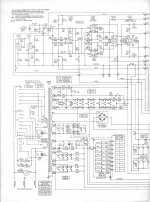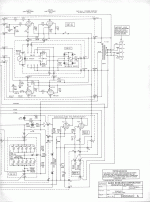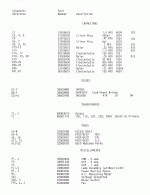I am having a problem with one of my Classic 150.
Upon turn on the High Voltage (Screen) LED immediately goes into dimmed mode indicating protective shutdown.
This usually happens when it has been played at excessive levels and the amplifier goes into protective shutdown. The reset process when that happens is to shut down the amplifier and wait for about 30 seconds then restart, the fault normally clears.
I cannot get the fault to clear.
I have checked the following:
-replaced speaker with 4 ohm load resistor, no change
-disconnected input cable, no change
-tested all 8 power tubes (6550), all test very strong
-spoke to ARC, they had no ideas
Prior to not using the amplifiers for a while I thought I noticed that on occasion that mono block tripped the protective shutdown at much lover listening levels than in the past, at the time I thought that I was merely 'imagining' it but perhaps this was a symptom.
Any suggestions?
Upon turn on the High Voltage (Screen) LED immediately goes into dimmed mode indicating protective shutdown.
This usually happens when it has been played at excessive levels and the amplifier goes into protective shutdown. The reset process when that happens is to shut down the amplifier and wait for about 30 seconds then restart, the fault normally clears.
I cannot get the fault to clear.
I have checked the following:
-replaced speaker with 4 ohm load resistor, no change
-disconnected input cable, no change
-tested all 8 power tubes (6550), all test very strong
-spoke to ARC, they had no ideas
Prior to not using the amplifiers for a while I thought I noticed that on occasion that mono block tripped the protective shutdown at much lover listening levels than in the past, at the time I thought that I was merely 'imagining' it but perhaps this was a symptom.
Any suggestions?
Can't do much without a schematic. However, odds are it's the optocoupler VTL5C4.
If the optocoupler goes bad, the output tubes are shut off by a large negative grid bias.
The Classic 150 is likely to be similar to the Classic 120, for which a schematic is available.
If the optocoupler goes bad, the output tubes are shut off by a large negative grid bias.
The Classic 150 is likely to be similar to the Classic 120, for which a schematic is available.
Last edited:
I have the schematic in pdf file but cannot seem to upload it, it differs from the Classic 120, I cannot even find VTL5C4
still not able, same issue as yesterday, I get the message:
Safari Can't Open the Page...The error is "cannot parse response"
Safari Can't Open the Page...The error is "cannot parse response"
Then upload directly from the web site using the web address option (below the first option in the window).
"Upload file from a URL"
"Upload file from a URL"
That is the D-150 from 1976, not the Classic 150.
The Classic 150 is very different. Which do you have?
The Classic 150 is very different. Which do you have?
My mistake -- I went back to the ARC archive website and while they do have some documentation for the Classic 150, there isn't a schematic available.
Sorry.
Sorry.
Some have said that the M300 is very similar to the Classic 150, except for the output stage.
If so, the bottom of the M300 power supply schematic has the standby LED, powered by a 15V
regulator that also powers the operate LED and the screen LED.
The standby switch SW2 triggers the standby LED and applies -125VDC (TP6) to the output grids
to shut off the output tubes. It is possible that this housekeeping circuit is faulty, rather than an actual
audio circuit fault. You would have to do some careful DC voltage measuring in this area to check
its operation.
I would encourage you to find a local technician familiar with tube circuits to do any further testing,
due to the lethal 600VDC high voltage (and high energy) present inside this amplifier. There should be
someone capable around the Toronto area. I will not go further here due to the extreme dangers involved.
If so, the bottom of the M300 power supply schematic has the standby LED, powered by a 15V
regulator that also powers the operate LED and the screen LED.
The standby switch SW2 triggers the standby LED and applies -125VDC (TP6) to the output grids
to shut off the output tubes. It is possible that this housekeeping circuit is faulty, rather than an actual
audio circuit fault. You would have to do some careful DC voltage measuring in this area to check
its operation.
I would encourage you to find a local technician familiar with tube circuits to do any further testing,
due to the lethal 600VDC high voltage (and high energy) present inside this amplifier. There should be
someone capable around the Toronto area. I will not go further here due to the extreme dangers involved.
Attachments
Last edited:
Yes, the Classic 150 has the same housekeeping circuitry and operation as the M300.
Post #12 still applies, especially about finding a local technician to do the work.
Don't know where you got that Classic 150 schematic, it's unobtanium.
Post #12 still applies, especially about finding a local technician to do the work.
Don't know where you got that Classic 150 schematic, it's unobtanium.
Last edited:
The schematic came in the back of my original manual, the manual posted on Audio Research DB has excluded those pages. Mine have been modified somewhat in order to simplify the input signal path using balanced input (XLR), eliminating the input attenuator and phase inverter. They have been functioning like this with no issues for decades, so that is not the issue.
I agree 100% on using extreme caution when working on these amplifiers, and that includes merely biasing them. I do not plan on probing test points inside searching for a faulty device. I was hoping someone here had encountered the same problem and had the solution for me, and am still hoping.
I have already spoken to a local ARC dealer for servicing next week if required.
I agree 100% on using extreme caution when working on these amplifiers, and that includes merely biasing them. I do not plan on probing test points inside searching for a faulty device. I was hoping someone here had encountered the same problem and had the solution for me, and am still hoping.
I have already spoken to a local ARC dealer for servicing next week if required.
"I was hoping someone here had encountered the same problem and had the solution for me,
and am still hoping."
Doesn't work that way. The entire related circuitry has to be verified for normal operation.
It's not like changing a flat tire, where the problem is obvious. There can be a cascading failure,
and/or multiple problems. An ARC dealer should have already done similar repairs many times
previously, and have the knowledge, equipment, and ARC replacement parts to do so safely.
and am still hoping."
Doesn't work that way. The entire related circuitry has to be verified for normal operation.
It's not like changing a flat tire, where the problem is obvious. There can be a cascading failure,
and/or multiple problems. An ARC dealer should have already done similar repairs many times
previously, and have the knowledge, equipment, and ARC replacement parts to do so safely.
Last edited:
"Doesn't work that way. The entire related circuitry has to be verified for normal operation.
It's not like changing a flat tire, where the problem is obvious. There can be a cascading failure,
and/or multiple problems. An ARC dealer should have already done similar repairs many times
previously, and have the knowledge, equipment, and ARC replacement parts to do so safely."
Not to be argumentative, but in reality they do. I have run multi million dollar electronics manufacturing facilities for decades with dozens of failure analysis engineers and technicians reporting to me. For our common legacy products we had a database of common faults with solutions. The process you describe, correctly, is what one would follow for the more unique failures. Effective manufacturing processes would dictate looking to the common faults first. As I mentioned in my initial posting I spoke to a technician at ARC who even checked such a database at their facility with no results.
My plan was/is to query this forum for past experience with this failure mode, look for a relatively simply common to solution to implement and failing that, take it to an ARC dealer for servicing.
Never the less, I appreciate everyone's interest, once the service technician completes the repair I will post the solution for reference in the future.
It's not like changing a flat tire, where the problem is obvious. There can be a cascading failure,
and/or multiple problems. An ARC dealer should have already done similar repairs many times
previously, and have the knowledge, equipment, and ARC replacement parts to do so safely."
Not to be argumentative, but in reality they do. I have run multi million dollar electronics manufacturing facilities for decades with dozens of failure analysis engineers and technicians reporting to me. For our common legacy products we had a database of common faults with solutions. The process you describe, correctly, is what one would follow for the more unique failures. Effective manufacturing processes would dictate looking to the common faults first. As I mentioned in my initial posting I spoke to a technician at ARC who even checked such a database at their facility with no results.
My plan was/is to query this forum for past experience with this failure mode, look for a relatively simply common to solution to implement and failing that, take it to an ARC dealer for servicing.
Never the less, I appreciate everyone's interest, once the service technician completes the repair I will post the solution for reference in the future.
I agree with Rayma. Using a list of most common faults/solution is the domain of shadetree mechanics and youtube diy-ers. By necessity. They lack both the expertise and the equipment necessary for analysis. All they can do is blindly replace parts until "it works".
A respectable electronics manufacturing facility has a test fixture that is used to quickly and fully verify operation and pinpoint the exact fault. A similar machine is used by well equipped service facilities/dealers as the case may be. At the very least, a respectable test facility should have a technician with good knowledge of the product and the equipment necessary to conduct a proper fault tree analysis, which fault tree should be part of a well written service manual.
In the case at hand here, you noted that you consulted with ARC and they had no idea. That tells you that it is not an obvious, well defined fault, i.e. Rayma's flat tire. The ARC Classic150 is not a mass market commodity with millions out in the field, so there won't be a large database of failures and their causes. In fact, ANY non-trivial failure of that amp will be rare, just as a matter of statistics.
Best bet: All you need is the schematic, a scope, DMM and a person able and willing to use them to troubleshoot the circuit.
A respectable electronics manufacturing facility has a test fixture that is used to quickly and fully verify operation and pinpoint the exact fault. A similar machine is used by well equipped service facilities/dealers as the case may be. At the very least, a respectable test facility should have a technician with good knowledge of the product and the equipment necessary to conduct a proper fault tree analysis, which fault tree should be part of a well written service manual.
In the case at hand here, you noted that you consulted with ARC and they had no idea. That tells you that it is not an obvious, well defined fault, i.e. Rayma's flat tire. The ARC Classic150 is not a mass market commodity with millions out in the field, so there won't be a large database of failures and their causes. In fact, ANY non-trivial failure of that amp will be rare, just as a matter of statistics.
Best bet: All you need is the schematic, a scope, DMM and a person able and willing to use them to troubleshoot the circuit.
.... with dozens of failure analysis engineers and technicians ... Effective manufacturing processes would dictate looking to the common faults...
Very true and has nothing to do with our situation here. The job of those engineers and technicians is to find faults and ELIMINATE them by changing the design and/or manufacturing process, hopefully before they reach the public. Or issue recalls if they already reached the public.
"Very true and has nothing to do with our situation here. The job of those engineers and technicians is to find faults and ELIMINATE them by changing the design and/or manufacturing process, hopefully before they reach the public. Or issue recalls if they already reached the public"
One doesn't know if the fault is common or not until the question is asked, which was my rational. My personal sample size is 2, not significant obviously.
Sorry for even asking at this point
One doesn't know if the fault is common or not until the question is asked, which was my rational. My personal sample size is 2, not significant obviously.
Sorry for even asking at this point
- Home
- Amplifiers
- Tubes / Valves
- ARC Classic 150 Problem



